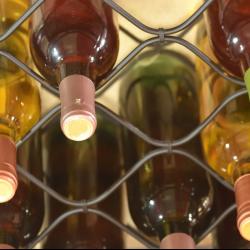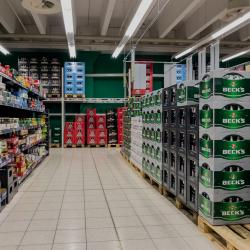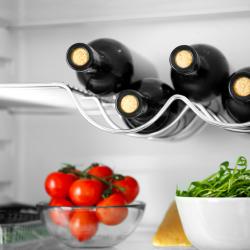The Beginner’s Guide to Wine Tasting
17-05-2020
Wine tasting is seen as the ultimate activity when it comes to adding some culture to your life. It comes with a certain air of class and elegance, expectations of a refined palate and knowing just what to say. However, how many people know how to taste wine properly?
Wine tasting may seem a little old hat to the wine connoisseur, but how often do you take the time to really appreciate the fine wines in your collection? Often just a small sip will suffice before you choose a bottle from your wall mounted wine racks or collection of wine, but it is the whole process that really makes wine tasting a special experience.
We aim to shatter the illusion and make wine tasting more accessible to everyone – after all, wine is there to be enjoyed! Wine tasting doesn’t need to be a complicated process; as soon as you understand the basic principles, you will begin to learn what you should be looking out for. Of course, it is always important to remember that everyone’s palate is different, meaning that personal tastes and preferences will always prevail.
Looking at your Wine
First things first, you need to choose which wine you are going to start with. Once the wine has been chosen from your contemporary wine racks and poured into your preferred wine glass of choice, you can begin to asses your wine! First, check out the colour, opacity and viscosity of the wine in the glass.
Give your wine a swirl, if you have wine that moves freely, much like water, this means your wine is very light. Compared to when the wine is very dense, with an almost ‘syrupy’ feeling, resulting in a drink that is normally very rich and, commonly, higher in alcohol content.
Now consider the various colours you notice; both reds and whites can vary in hue and vibrancy which can give you a good idea of the quality of the wine you are tasting. Gently tilt your glass under natural light and hold over a pale, preferably white coloured background, the colour you are looking at is where the edge of the wine meets the glass.
Wines with a redder hue typically have a higher acidity than those of purple or blue tones. While deeper, richer tones in colour with low opacity normally indicates a fuller-bodied wine with a high level of pigments. As white wines age, they darken in colour, so a white wine of medium or deep amber tones will taste much different than the same wine type in a pale or medium straw colour.
Follow Your Nose
50% of taste comes from smell, so your nose is as important a tool as your palate when it comes to wine tasting. Pick a bottle from your wine rack and pour a small amount into a glass to taste. The first step should be to swirl the wine around the glass before you taste it. This will allow you to smell the aroma of the wine and can also help you to identify if there are any problems.
There are three subcategories for detecting the aroma of wine:
Primary – the most dominant aromas, helping you identify one grape from another. Once you can clearly recognise the difference, each wine will become easier to identify.
Secondary – background flavours, usually as a result of the production process. This requires more of an educated nose but can be picked up over time.
Tertiary – aromas stemming from the ageing process in the bottle or barrel, typically you can notice cloves, vanilla, tobacco and mushrooms.
Although it can be difficult to pick the subtle aromas out at first, with practice, you will become much more proficient at detecting the individual scents and flavours present.
What to Look Out For
Next, comes taste. Flavour is detected on the palate, but the most important aspects to take into consideration are the acidity, sweetness, and tannins. These will dictate the style of the wine and also help when it comes to finding the perfect food pairing. It’s also common to hear professional wine tasters talking about the body of the wine - this is the overall feel and intensity of the wine.
Wine-tasting terms to familiarise yourself with;
Body – The body of the wine is a descriptive term used to identify the ‘fullness’ of the wine and how it feels in your mouth. Full-bodied wines are deep in hue, rich in taste and often high in alcohol % while lighter body wines are much more delicate.
Tannins – These are the most apparent in red wines and are known for causing a sense of dry mouth, which can occur towards the back of the tongue. Young red wine will always have a certain degree of intensity to the palate and are much higher in tannins than aged wine which gradually reduces in levels of tannin over time.
Acidity – Acids found in wines are generally malic, tartaric or lactic. When you taste wine you usually experience a tingling sensation in the back of your throat causing your mouth to water. This is caused by adding odourless acids to the wine, giving the wine a sharp and lively taste. To test the acidity level in the wine, just wait for your mouth to water and the longer it lasts, the stronger the acid is. Finding the balance of acids in the wine is important, too much and you risk a tart, sour-tasting wine, too little and your wine can seem bland and tasteless.
Finally, you will need to either swallow or spit out the wine to understand the finish. As a general rule, when the positive aftertaste of the wine lingers for a minute or so, you can be confident in the quality of your wine. A ‘short finish’ in a wine usually means the flavour of the wine will disappear in a few seconds, which is normally associated with lower quality wines.
Concluding the Flavour of your Wine
In the end, you want to assess the balance of the wine you have tasted. The balance between fruit and sugar levels must be in accordance with the acidity and tannin in wines. As mentioned above, too much acidity or tannin levels will leave an unfavourable taste in your mouth, while too much fruit and sugar can seem overly heavy and thick. Each component of the wine will need to blend together in a balanced way otherwise it creates a poor quality of wine.
Fancy trying out your knowledge with your own wine tasting session? Restock your wall mounted wine racks and invite some friends round for the perfect enjoyable evening.
Got the perfect space to fill but struggling to find your ideal wine rack? We offer a bespoke wine rack service, building you a fully custom wine rack in a selection of wood or metal finishes, get in touch or visit our bespoke wine rack page for more information.Visit the Cranville Wine Racks website for more information on The Beginner’s Guide to Wine Tasting






